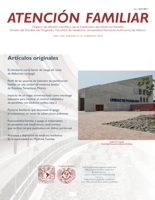Climacteric as a Risk Factor in Cases of Marital Dysfunction
Main Article Content
Abstract
Objective: to evaluate marital functionality during female climacteric. Material and methods: descriptive observational study of cross-section in a not randomized sample in which it was studied 100 women aged 45 to 60 who met the inclusion and exclusion criteria. It was applied an interview with prior consent that included: 1) socio-demographic background of the woman and her partner, 2) stage of the climacteric and its features and 3) scale of evaluation of marital functionality. Data were analyzed through frequency measures and risk analysis to measure the association. Results: average age of 51 years, with a low education level. Occupation: housewife and maid. 85% were married and they belonged to a family, the family income was low. 63% of them were in the postmenopausal stage. Marital dysfunction arose more frequently in the stage of post menopause (75%). It was found that climacteric was as a risk factor for marital dysfunction (or=2.6, with ic 1-6, p=0.02). Marital functions with greater impact were communication and affection with an or of 48.1 and 41, respectively. Economic income influenced in marital dysfunction (orMH=5 with ic 1.6-21, p=0.003); the rest of the socio-demographic variables was not significant. The association with hot flashes (or=2.3, with ic 1-5, p=0.04). Conclusions: post menopause stages in a risk factor for marital dysfunction. Inadequate communication and lack of affections were the functions which more strongly associated with marital dysfunction.
Downloads
Download data is not yet available.
Article Details
How to Cite
Pavón-Mendoza, N., Dickinson-Bannack, M. E., & González-Salinas, C. (2015). Climacteric as a Risk Factor in Cases of Marital Dysfunction. Atención Familiar, 21(2). https://doi.org/10.22201/facmed.14058871p.2014.2.47905
